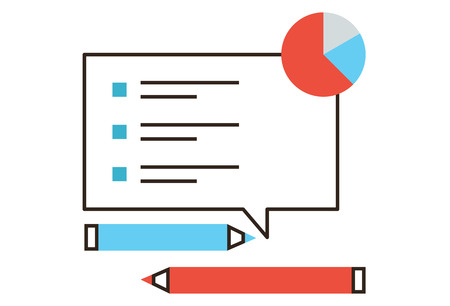Election Polls and How They Missed the Mark

38867162 – thin line icon with flat design element of checklist analysis, market monitoring, survey list, feedback form, poll questions, marketing research. modern style logo vector illustration concept.
December 9, 2016
The election is complete and America now has a new president, a president many people thought could not win, including the many polls done before November 8. In fact, according to Politico.com, “When Election Day dawned, almost all the pollsters, analytics nerds and political insiders in the country had Hillary Clinton waltzing into the White House.” According to the Pew Research Center, Clinton’s chances of winning were predicted at anywhere from 70 to 99 percent.
So how did everyone get it so wrong? Well, as of now there is no one reason — it seems to be a combination of factors. But according to the Pew Research Center, “Across the board, polls underestimated Trump’s level of support.”
This underestimation of support may have been caused by a non-response bias. According to Pew, “This occurs when certain kinds of people systematically do not respond to surveys despite equal opportunity outreach to all parts of the electorate.” It has been found that uneducated whites are consistently harder for pollsters to reach, a group that was key to Trump’s win.
But why did this group not respond to polls if they had equal opportunity to do so? The belief is that less-educated voters are frustrated and have “anti-institutional” feelings that make them unlikely to respond to polls. According to Pew, “The result would be a strongly pro-Trump segment of the population that simply did not show up in the polls in proportion to their actual share of the population.”
Another likely reason for the incorrect polls is the so-called “shy-Trumpers.” Because it seemed “socially undesirable” to support Trump, many of the people planning to vote for him were unwilling to admit their support to pollsters, creating a distorted lead in the polls for Clinton.
But perhaps the problem with the incorrect polls is not the polls themselves but how people interpret them. Allan Lichtman, a professor of history at American University who has accurately predicted nine of the presidential elections since 1984 including this year’s, claims, “Polls are snapshots. They are not predictors.” They simply show where the candidates are at that moment, not where they will be by November 8.
In fact, according to Sean Trende, a senior elections analyst for RealClearPolitics, their polls were off by an acceptable margin of error: “We had a two-point margin for Clinton. And Trump ended up winning by a point, which is, you know, within the normal sampling error of 2016.”
But no matter the reason, the polls were off this election and many people were taken by surprise. That leaves the question: Will polling go away after the failures of this election?
The short answer is no. According to Jeanne Zaino writing in the Huffington Post, “Election polling is big business and it isn’t going anywhere anytime soon.”
However, that doesn’t mean there won’t be any ramifications after this election. In fact, according to USA Today, “Many public polls have already disappeared as news organizations ended them amid deteriorating finances.”
The most likely outcome of these errors is a distrust of polls in the future. “At some point you have to be at least reasonably close,” said Terry Jones, commentator editor at Investor’s Business Daily. “If you’re not making corrections to your polling technique to represent what’s happened, your value goes down.”

